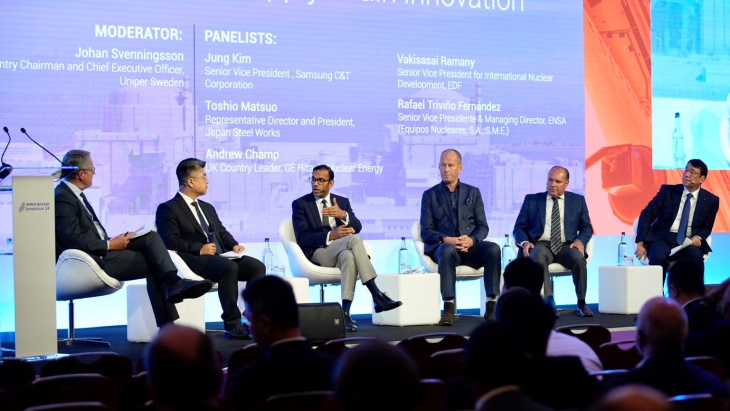Opening the session - titled Forging Ahead: Increasing industrial capacity and supply chain innovation - moderator Johan Svenningsson, CEO of Uniper Sweden, described the nuclear supply chain as "a complex and highly-regulated network". He said: "It involves production, transportation, management of materials, components, services - which is essential for the construction, operation and maintenance of all the nuclear facilities."
However, to enable the tripling of nuclear capacity to 2050, he said the supply chain will need to expand and innovate the support of the construction of nuclear power plants in addition to supporting the long-term operation and modernisation of the existing plants.
Vakisasai Ramany, senior vice president for International Nuclear Development at EDF, noted: "We must remind ourselves that we did it before - not just in France, but in many countries around the world - so it is possible." However, he added: "Whilst we have done it in the past - in France we built 58 reactors in a span of roughly 25 years - having done that, over the past two decades we have basically been at a pace of one reactor per decade and we have to move to multiplying this by five, up to a pace where we can connect two reactors per year to the grid. Whilst it's reassuring to know we have been able to do it in the past, the context has changed."
He said the challenge is "now much bigger" because the regulatory requirements are different, reactor designs have become more complex and it is a "more demanding environment with the public, requiring transparency". Ramany said that an environment needs to been created where there is strong confidence - "it's all about confidence at the end".
The best way to construct large reactors is "to do, learn and repeat", Ramany said. "And this is why we want to go for series where we can have reactors being built one after the other rather than having long gaps between the reactors and have time to forget what we have learned. For SMRs, this is made even more compelling because the idea is to reduce the construction time by having modules made offsite as much as possible and with assembly being done onsite within a very limited timeframe. For that to happen, it's a much more complex ecosystem we have to create."
Jung Kim, senior vice president of Samsung C&T Corporation said the company's goal is to "create and establish a proven track record which will demonstrate our ability to manage large, complex nuclear projects effectively - as we have done for the Barakah nuclear power plant project as well as ongoing and past nuclear construction projects in Korea."
Japan Steel Works (JSW) Representative Director and President Toshio Matsuo agreed that experience was the most important factor. He noted the company had delivered more than 3000 nuclear components since 1970 and supplied many first-of-a-kind projects. "The knowledge gained from manufacturing is an asset to support different customer requirements. New demand and markets present both a challenge and an opportunity for JSW. JSW intends to respond flexibly based on our experience."
When asked how current bottlenecks in the supply chain can be overcome, Andrew Champ, UK Country Leader for GE Hitachi Nuclear Energy, said the first requirement was "long-term, consistent policy" by governments to show their commitment to future nuclear new build projects. "And then you've got to follow that through with a risk-sharing framework that enables clients to be able to come forwards," he said. "Once you've got that then you can start really making progress in terms of investments going forwards ... we need to see future sites, we need to see a pipeline, we need to see a fleet of deployment going forwards. That really gives investment from OEMs like ourselves to establish modularisation factories or fuel assembly facilities or our supply chain to invest in manufacturing in the country. They want to see that predictability."
Champ also said there needs to be international regulatory alignment, with consistency of reactor designs that can be replicated globally.
"In the short-term, ultimately we need contracts. I'm a big believer the supply chain will innovate and deliver solutions, but it operates in a relatively short timeframe - it needs those strong market signals to make those investments," he added.
Rafael Triviño Fernández, senior vice president and managing director of Spain's ENSA said he expects to see a "big ramp-up" of nuclear programmes, adding, "We have been thinking about how to enlarge our facilities and how we can deliver the expectations of the clients ... we need to be prepared with the capabilities and the people, but the industry needs to work together to reduce the time that's needed."
Closing the session, Svenningsson said: "Actually talking about scaling up supply chains tells us we are moving closer to realising this growth that we want to see. There's still a lot of work and activities to be done, but I'm sure we will make it because we made it before in a lot of countries and we need to work together and make it happen."





_47120.jpg)
_23621.jpg)

_63865.jpg)





